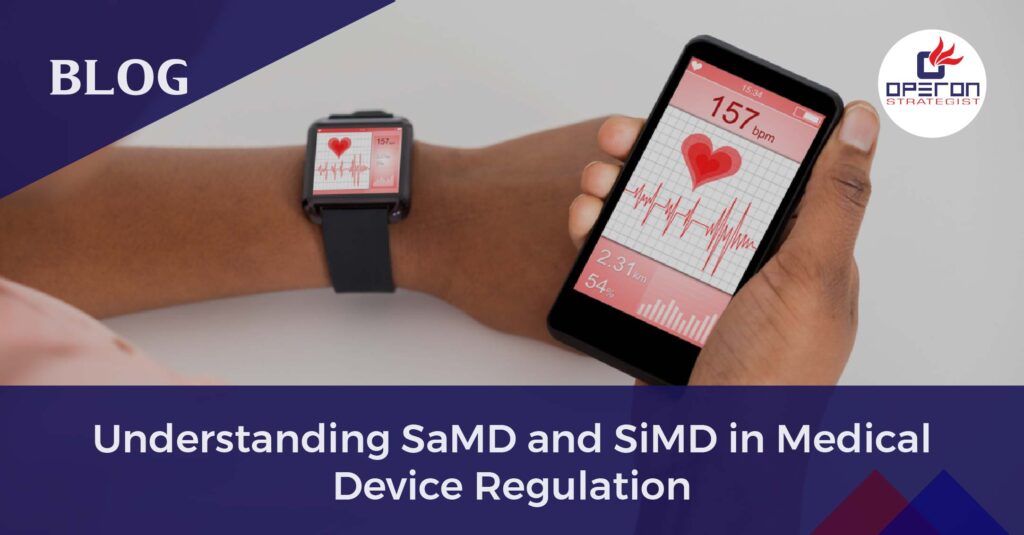Why SaMD and SiMD Matter in Medical Device Innovation
In today’s fast-paced healthcare technology landscape, software plays a transformative role in improving patient care and operational efficiency. However, not all medical software is treated equally from a regulatory standpoint. Two critical terms you must understand are SaMD (Software as a Medical Device) and SiMD (Software in a Medical Device). These classifications have significant implications for compliance, safety, and market entry strategies across global regions such as the USA, Europe, and India. In this guide, Operon Strategist, a trusted regulatory consulting partner, explains the nuances, risks, and requirements associated with SaMD and SiMD.
Read more about CDSCO Registration for Software as a Medical Device
Looking for a Medical Device Regulatory Consultant
What is SaMD and SiMD?
SaMD – Software as a Medical Device
Software that is developed and intended for medical purposes but functions independently of any specific hardware. It may be distributed across various platforms, such as smartphones, cloud-based services, or standalone applications. Examples include apps that monitor heart rate, diagnostic tools, or AI-powered clinical decision systems.
SiMD – Software in a Medical Device
Software embedded within or integrated as part of a medical device’s hardware ecosystem. SiMD is essential for the operation, control, or processing functions of a device like infusion pumps, cardiac monitors, or imaging machines.
Also read, SaMD Classification and Submission as per USFDA
SaMD vs SiMD – Key Differences Explained
| Aspect | SaMD | SiMD |
|---|---|---|
| Definition | Independent software intended for medical use | Software embedded or integrated within a hardware medical device |
| Risk Level | Depends on intended medical purpose but generally lower | Higher due to direct interaction with hardware components |
| Development Focus | Software-specific testing and compatibility | Software-hardware integration validation |
| Regulatory Framework | Often regulated as a standalone device | Regulated alongside associated hardware |
| Documentation | Clinical validation, lifecycle, and surveillance | Interface validation, compatibility, and integrated risk management |
| Patient Safety | Relies on software’s medical accuracy | Integration failures could impact device performance |
You can also read A Guide to SaMD (Software as a Medical Device)
Regulatory Compliance: What You Need to Know
Both SaMD and SiMD must meet strict safety and efficacy standards, but the approach varies depending on integration and intended use.
Standards Applicable to Both:
- IEC 62304 – Software lifecycle processes
- IEC 62366 – Usability engineering
- ISO 14971 – Risk management for medical devices
Additional Considerations for SiMD:
- Software-hardware interface validation
- Compatibility testing
- Integrated risk management strategies
Global Regulatory Frameworks:
- USA: FDA Software Precertification Program, 21 CFR Part 820
- Europe: Medical Device Regulation (MDR)
- India: CDSCO Registration for medical software
- Others: Local standards depending on healthcare infrastructure
SaMD often faces a simplified regulatory pathway compared to SiMD, which requires combined hardware assessments and validation protocols.
Risk Management: Avoiding Common Pitfalls
SaMD Risks:
- Incorrect medical advice or data interpretation
- Compatibility issues with platforms
- Lack of updates and post-market surveillance
SiMD Risks:
- Faulty integration with hardware
- Communication errors between components
- Compromised safety due to interface failures
Proper risk assessment, documentation, and validation processes are essential in both cases to safeguard patients and ensure compliance.
Documentation Requirements – A Step-by-Step Breakdown
SaMD Documentation Checklist:
- Clinical validation reports
- Software development lifecycle plans
- Risk assessment and mitigation strategies
- Post-market monitoring protocols
SiMD Documentation Checklist:
- Interface validation and testing reports
- Hardware-software compatibility data
- Integrated risk analysis
- Verification and validation processes aligned with device requirements
Thorough documentation not only ensures compliance but also builds trust with healthcare providers and patients.
Real-World Examples
SaMD Examples:
- Mobile apps that monitor blood glucose levels
- AI algorithms that detect abnormalities in imaging scans
- Cloud-based decision support tools for doctors
SiMD Examples:
- Infusion pumps controlled by embedded software
- Cardiac monitors using proprietary algorithms
- Diagnostic imaging machines with integrated processing software
Understanding these examples helps guide development strategies and compliance pathways.
Ensure SaMD & SiMD Compliance with Expert Guidance
How Operon Strategist Supports You
At Operon Strategist, we guide innovators from concept to market with end-to-end regulatory consulting for SaMD and SiMD products.
Our Services Include:
✔ Regulatory assessment and classification
✔ Compliance strategy aligned with global standards
✔ Documentation preparation and review
✔ Submission support for FDA, CE, CDSCO, and other authorities
✔ Post-market surveillance and risk management
✔ Training on IEC 62304 and ISO 13485 standards
With our expert team’s hands-on experience, we help you minimize risks, avoid delays, and confidently navigate the regulatory environment.
- adminhttps://operonstrategist.com/author/admin-2/
- adminhttps://operonstrategist.com/author/admin-2/
- adminhttps://operonstrategist.com/author/admin-2/
- adminhttps://operonstrategist.com/author/admin-2/




